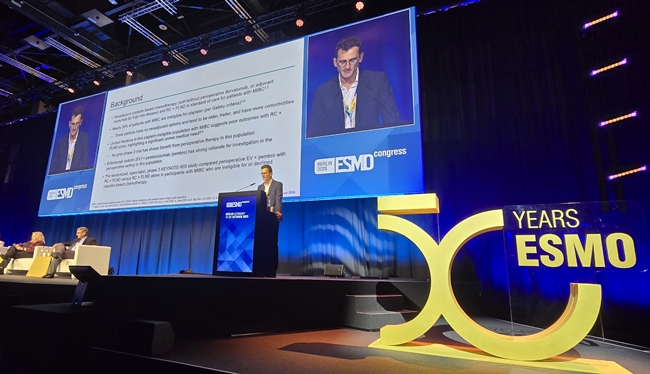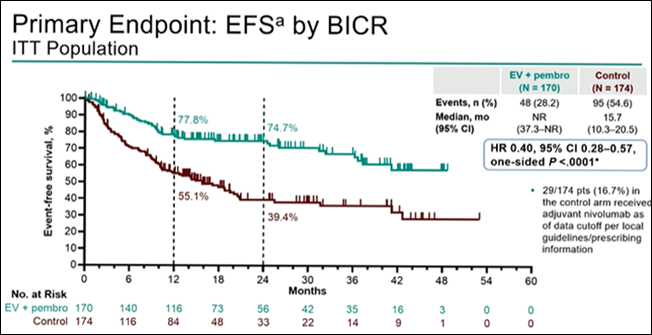- 'Keytruda+Padcev' proposed as a new standard trt for MIBC
- by Hwang, byoung woo | translator Hong, Ji Yeon | Oct 20, 2025 06:07am
Analysis suggests that the combination of enfortumab vedotin and pembrolizumab may shift the perioperative standard of care for MIBC patients who are ineligible for or refuse cisplatin.

On October 18 (local time), the Phase 3 KEYNOTE-905/EV-303 results (LBA2) were presented at the ESMO Congress 2025 (European Society for Medical Oncology). The study evaluated the combination of Padcev and Keytruda before and after radical cystectomy + pelvic lymph node dissection (RC+PLND), the current standard of care, in MIBC patients who were ineligible for or refused cisplatin.
Perioperative EV + pembrolizumab combination therapy improved the survival index significantly선
Professor Christof Vulsteke of AZ Maria Middelares Hospital in Belgium delivered the Phase 3 clinical trial results as an oral presentation during the Presidential Symposium I.

The study results showed that the Padcev + Keytruda combination therapy demonstrated statistically significant improvements in event-free survival (EFS), overall survival (OS), and pathological complete response rate (pCR) compared to RC+PLND monotherapy.
First, EFS was significantly improved in the combination group, with the median not yet reached, compared to 15.7 months in the control group (Hazard Ratio [HR] 0.40; 95% CI 0.28–0.57; P < 0.0001).
Overall survival (OS) also showed a statistical advantage in the combination group, with the median not yet reached, compared to 41.7 months in the control group (HR 0.50; 95% CI 0.33–0.74; P = 0.0002).
This performance garnered significant applause during the presentation of EFS and OS results.
The pCR also showed a stark difference: 57.1% in the combination arm versus 8.6% in the control arm, a difference of nearly 48 percentage points (P < 0.000001).

Professor Vulsteke said, "This study is the first randomized Phase 3 result to clearly demonstrate a survival benefit from perioperative combination therapy in patients with resectable, cisplatin-ineligible MIBC," and explained that "the Padcev + Keytruda combination demonstrated the potential to replace the existing chemotherapy-centric treatment paradigm."
The median age of the patients was 74, and the reasons for cisplatin ineligibility varied, including reduced kidney function, hearing impairment, and neuropathy. However, the benefit of the Padcev + Keytruda combination was consistently maintained across subgroup analyses by age and comorbidity.
However, the incidence of Grade 3 or higher adverse events was higher in the combination group (71.3%) compared to the control group (45.9%), emphasizing the importance of patient selection and management during clinical application.
"Clarity needed on stage-specific contribution of treatment before and after surgery"

Professor Rosenberg further stressed, "Clearly defining the contribution of treatment in the neoadjuvant and adjuvant stages, and optimizing therapy through circulating tumor DNA (ctDNA) analysis, will be important future tasks."
Regarding the management of relapsed and metastatic patients, he suggested, "Platinum-based chemotherapy may still be considered the standard for patients who relapse early after Padcev + Keytruda," and proposed that "research into new treatment orders is needed in the post-EV combination era."
Experts analyzed that, based on these results, the focus of bladder cancer treatment is shifting from traditional cisplatin chemotherapy to EV-based combination therapy, assessing this as a signal for a paradigm shift in the treatment of MIBC.
-

- 0
댓글 운영방식은
댓글은 실명게재와 익명게재 방식이 있으며, 실명은 이름과 아이디가 노출됩니다. 익명은 필명으로 등록 가능하며, 대댓글은 익명으로 등록 가능합니다.
댓글 노출방식은
댓글 명예자문위원(팜-코니언-필기모양 아이콘)으로 위촉된 데일리팜 회원의 댓글은 ‘게시판형 보기’와 ’펼쳐보기형’ 리스트에서 항상 최상단에 노출됩니다. 새로운 댓글을 올리는 일반회원은 ‘게시판형’과 ‘펼쳐보기형’ 모두 팜코니언 회원이 쓴 댓글의 하단에 실시간 노출됩니다.
댓글의 삭제 기준은
다음의 경우 사전 통보없이 삭제하고 아이디 이용정지 또는 영구 가입제한이 될 수도 있습니다.
-
저작권·인격권 등 타인의 권리를 침해하는 경우
상용 프로그램의 등록과 게재, 배포를 안내하는 게시물
타인 또는 제3자의 저작권 및 기타 권리를 침해한 내용을 담은 게시물
-
근거 없는 비방·명예를 훼손하는 게시물
특정 이용자 및 개인에 대한 인신 공격적인 내용의 글 및 직접적인 욕설이 사용된 경우
특정 지역 및 종교간의 감정대립을 조장하는 내용
사실 확인이 안된 소문을 유포 시키는 경우
욕설과 비어, 속어를 담은 내용
정당법 및 공직선거법, 관계 법령에 저촉되는 경우(선관위 요청 시 즉시 삭제)
특정 지역이나 단체를 비하하는 경우
특정인의 명예를 훼손하여 해당인이 삭제를 요청하는 경우
특정인의 개인정보(주민등록번호, 전화, 상세주소 등)를 무단으로 게시하는 경우
타인의 ID 혹은 닉네임을 도용하는 경우
-
게시판 특성상 제한되는 내용
서비스 주제와 맞지 않는 내용의 글을 게재한 경우
동일 내용의 연속 게재 및 여러 기사에 중복 게재한 경우
부분적으로 변경하여 반복 게재하는 경우도 포함
제목과 관련 없는 내용의 게시물, 제목과 본문이 무관한 경우
돈벌기 및 직·간접 상업적 목적의 내용이 포함된 게시물
게시물 읽기 유도 등을 위해 내용과 무관한 제목을 사용한 경우
-
수사기관 등의 공식적인 요청이 있는 경우
-
기타사항
각 서비스의 필요성에 따라 미리 공지한 경우
기타 법률에 저촉되는 정보 게재를 목적으로 할 경우
기타 원만한 운영을 위해 운영자가 필요하다고 판단되는 내용
-
사실 관계 확인 후 삭제
저작권자로부터 허락받지 않은 내용을 무단 게재, 복제, 배포하는 경우
타인의 초상권을 침해하거나 개인정보를 유출하는 경우
당사에 제공한 이용자의 정보가 허위인 경우 (타인의 ID, 비밀번호 도용 등)
※이상의 내용중 일부 사항에 적용될 경우 이용약관 및 관련 법률에 의해 제재를 받으실 수도 있으며, 민·형사상 처벌을 받을 수도 있습니다.
※위에 명시되지 않은 내용이더라도 불법적인 내용으로 판단되거나 데일리팜 서비스에 바람직하지 않다고 판단되는 경우는 선 조치 이후 본 관리 기준을 수정 공시하겠습니다.
※기타 문의 사항은 데일리팜 운영자에게 연락주십시오. 메일 주소는 dailypharm@dailypharm.com입니다.
- [Op-Ed] Patients, no time left for 'new drug comb therapies'
- Special Contribution | Eo, Yun-Ho









